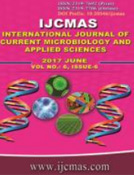


 National Academy of Agricultural Sciences (NAAS)
National Academy of Agricultural Sciences (NAAS)

|
PRINT ISSN : 2319-7692
Online ISSN : 2319-7706 Issues : 12 per year Publisher : Excellent Publishers Email : editorijcmas@gmail.com / submit@ijcmas.com Editor-in-chief: Dr.M.Prakash Index Copernicus ICV 2018: 95.39 NAAS RATING 2020: 5.38 |
The flesh fly Sarcophaga ruficornis is a pest of veterinary importance as it affects various animals reared for livestock including cows, buffaloes, sheep, and goats causing myiasis, which results in huge economic loss to the livestock owners. Various attempts have been made to control this fly using different chemical formulations. Barium carbonate is highly toxic compound upon acute and chronic exposures. Barium compounds have been found to have a toxic effect on different animal models. These were found to be cytotoxic and genotoxic to WTHBF-6 cells; cardiotoxic in rabbits and have been found to show toxic effects on Rhabditis marina. As BaCO3 is a known rodenticide, the effect of barium carbonate was observed on the developmental stages of S. ruficornis starting from larval stage till the adult emergence has been assessed in the present study so as to check the potency of BaCO3 as an effective control chemical for S. ruficornis. 3rd instar larvae of S. ruficornis were given an exposure of different graded concentrations (0.01, 0.001, 0.0001 and 0.00001 g/ml) of BaCO3 to observe the toxic effects on larval and pupal stages. To the best of our knowledge, this is the first report on the toxicity of BaCO3 on the different life stages of S. ruficornis. Results revealed the mild toxic effect on the development cycle of S. ruficornis with pupal mortality and a decrease in adult emergence. Present study confirms a mild yet toxic potential of BaCO3 to hinder the life cycle of S. ruficornis. Further short term toxic studies are required so as to claim the efficiency of BaCO3 in controlling fly populations.
 |
 |
 |
 |
 |